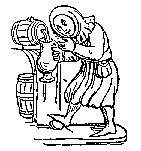The Brewing Process
Without getting too technical, the first step in making beer is to
convert the starches in the malt into fermentable sugars. Hops are
added and act as both a flavoring and a preserving agent. The
yeast is introduced into the unfinished beer, known as wort
(pronounced wert), and proceeds to consume the sugars, with the
byproducts including alcohol and carbon dioxide.
There is a tremendous amount of variation on the brewing process
involving different kinds of malt, hops, and yeast. Even the type
of water used has a distinct effect upon the flavor of the finished
product.
Water
Not surprisingly, the ingredient that makes up most of the volume
in beer also has a great affect upon its taste. There are two
variables that are important considerations when brewing beer, the
alkalinity (or pH level) and the amount of minerals in the brewing
water. Put simply, low alkaline water is most conducive to the
enzymes that break down the starches present in the brewing grains
and/or adjuncts. Calcium ions, the most significant mineral in the
brewing process, react with the phosphates naturally present in the
grains and thereby lower the pH level of the mash. Additionally,
calcium tends to promote the enzymatic degradation of starch, aids
in the hop-flavoring process, and inhibits certain off-flavors from
developing in the beer.
The most famous beer-making regions rely upon the qualities of the
local water to make their brews unique. And indeed, you may notice
that all brands of beer from a particular brewery have a similar
under-riding flavor that, more often than not, is caused by the
source of water.
Malt
Probably the single most vital ingredient in beer is the malted
barley that the yeast ultimately relies and feeds upon. Not
coincidentally, the earliest civilizations to harvest barley are
also regarded as those first to process the grain into beer.
Malt is made by a manner in which the edible seeds of the barley
plant (known as barleycorns), produce the sugars and starches
necessary for brewing, as well as the enzymes that will break down
those starches into more palatable sugars.
Essentially, the barley is allowed to germinate through immersion
in water and then allowed to dry at a controlled and steadily
increasing rate. During germination, the barleycorn naturally
generates sugars and starches essential for growth and development
of the new barley plant. Maltsters control this process to produce
a variety of malts. The rootlets produced during germination are
then removed, and the malted barley is then ready for use in
brewing.
Once the barley is malted, the brewing process may begin. The
first step in this process involves converting the starches into
sugars through a method called mashing. There are several ways to
mash the malt, but essentially, the grains are added to water and
heated to a specific temperature and kept there for a specified
amount of time (is that vague enough?) This heat-rest procedure
(it is sometimes performed in stages, known as step mashing)
activates the alpha- and beta-amylase enzymes that proceed to
degrade the malt starches into fermentable sugars.
Roasting malted barley and certain methods of tweaking the malting
process produces "specialty" grains like black patent, chocolate
and crystal malts. These are employed as flavoring and coloring
agents for many varieties of beer, but often contain no enzymes.
Hops
Hops are the aromatic flowers of the hop vine (Humulus
lupulus). The cultivation of hops dates back to at least the
ninth century, and were used for medicinal purposes, as well as for
flavoring beer--though this practice was generally restricted to
Germany. Hops were also found to be a natural antiseptic and
preservative. Other plants and herbs were recognized for their
preservative attributes (spruce, ginger, sage, etc.), but hops
became the favored choice due primarily to its ease of cultivation
and its flavoring qualities.
The major hop-producing regions of the world generally lie within
areas that have cool, wet climates, namely Germany, southern
England, southern Australia, Tasmania, and the Pacific Northwest
region of the United States.
Yeast and Beer Styles
There are two basic types of beer: ale and lager. Ales are
produced using a strain of yeast known as Saccharomyces
cerevisiae. These yeasts thrive at warm temperatures (60°
to 75°F), and are termed "top-fermenting" as they do their
business at the top of the wort. Ale was once the most widespread
style of beer as it could be brewed almost anywhere and at
virtually any time of the year.
Types of beer made with ale yeast include porters, stouts, and of
course, ales.
Lagers are produced in colder temperatures (50° to 55°F for
initial fermentation, and 32° to 45°F thereafter). Yeasts
used in this process (Saccharomyces uvarum) are called
"bottom-fermenting" as they--you guessed it--thrive at the bottom
of the wort. Beers brewed in this way can trace their roots back
to pre-medieval Bavaria, where beers were brewed and stored in
dark, cold caves. Wild yeasts that inhabited such environments fed
on the wort and the results were pleasing enough that the practice
continued.
Lager-fermented beer styles include pilsners, bocks and
doppelbocks.
Apart from the aforementioned yeasts and their sub-types, or
strains, there are many other kinds employed by brewers, depending
on local tastes and regional traditions. Some Belgian brews, like
the renowned lambics and krieks, are fermented using a variety of
wild yeasts as well as certain, brewery-specific bacteria.
A Word on Adjuncts and Sundry Ingredients
It is possible to extract fermentable sugars from grains other than
barley. And although they significantly alter the outcome of the
beer, brewers have not hesitated from using them, often with
pleasing results. These other grains, or adjuncts, include rice,
maize, rye, wheat and even oats. Rice for example, although it
does not inhibit the malt flavor, lends a dry crispness to the
beer. Wheat is combined with barley to produce the famed German
weissbiers.
Most of the commercial American breweries use rice, corn or other
adjuncts as an additional source of sugars. They did so in the
beginning mainly to cut costs, but the results have been so popular
that it has become a style all its own.
The Germans, on the other hand, have a purity law known as the
Rhineheitsgebot, which strictly dictates the quality and
type of ingredients allowed to be put in beer. Most American
microbreweries and brewpubs follow similar standards in order to
make beers that are far superior to their mass-produced cousins.
Additionally, many things can be added to enhance or otherwise
alter the taste of the beer. Many of the popular Belgian brews use
raspberries or cherries. Chili peppers, honey, raspberries,
pumpkin, spruce needles--all have been added to beer (with varying
results!)
American Tastes
Ales were the most popular types of beer in America until the great
influx of Germans began to arrive on our shores in the 1830s and
1840s, bringing with them their traditions and culture--not the
least of which was their tremendous knowledge of brewcraft. It was
about this time too that scientific interest in brewing had reached
the point whereby lager yeasts had been identified and a viable
means for transporting them across the Atlantic had been found.
Lager beer rapidly became the popular favorite and, although ales
never completely fell out of favor, it was not until the last
fifteen years or so that the traditional American Pilsner had any
real competition in the U.S. marketplace.
Go to a discussion about Minnesota's earliest
breweries.

 Beer, in its purest form, is comprised of water, malted barley,
hops and yeast. Its brewing is an ancient art dating back to
Mesopotamia, ca. 2000 BC, the same region where barley is believed
to have first been cultivated. As the cultivation of barley
spread, so did beer. And so, in time, the peoples of Europe became
especially skilled at the art of brewing. While most of the
Mediterranean cultures preferred wine (their climates being
favorable to the cultivation of grapes), the more northern lands,
especially Germany and England, came to embrace beer.
Beer, in its purest form, is comprised of water, malted barley,
hops and yeast. Its brewing is an ancient art dating back to
Mesopotamia, ca. 2000 BC, the same region where barley is believed
to have first been cultivated. As the cultivation of barley
spread, so did beer. And so, in time, the peoples of Europe became
especially skilled at the art of brewing. While most of the
Mediterranean cultures preferred wine (their climates being
favorable to the cultivation of grapes), the more northern lands,
especially Germany and England, came to embrace beer.
 Beer has since spread around the world, enjoyed by nearly every
culture that it has touched. Although there are almost as many
different styles as there are people that drink beer, this "nectar
of the gods" still relies upon four basic ingredients: water, malt,
hops and yeast.
Beer has since spread around the world, enjoyed by nearly every
culture that it has touched. Although there are almost as many
different styles as there are people that drink beer, this "nectar
of the gods" still relies upon four basic ingredients: water, malt,
hops and yeast.
